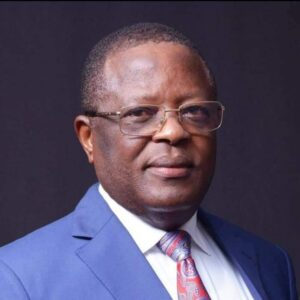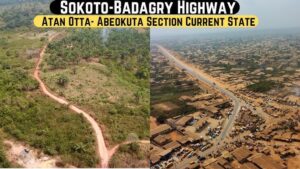Nigeria is finally witnessing the execution of one of its most ambitious infrastructure dreams — the ~1,068 km Sokoto–Badagry Super Highway, cutting through six states: Sokoto, Kebbi, Niger, Kwara, Ogun, and Lagos. Long delayed under successive governments, the project has moved decisively from paper to progress under President Bola Ahmed Tinubu’s All Progressives Congress (APC) administration.
Within just two years, President Tinubu’s APC-led government has achieved more physical infrastructure progress than any administration in comparable time — including the Lagos–Calabar Coastal Highway, ongoing rail expansions, and now this transformational superhighway linking the far Northwest to the Atlantic coast. These tangible achievements have reignited national confidence, prompted high-profile political defections to the APC, and validated the Renewed Hope Agenda as a realistic, results-driven national program.

From Decades of Delay to Construction Reality
The Sokoto–Badagry Super Highway has existed in federal plans for decades, envisioned as a strategic corridor connecting Nigeria’s agricultural heartlands in the North-West to industrial and export hubs in the South-West. Despite repeated promises, successive administrations lacked the coordination, funding, or political will to implement it.
That changed under the Tinubu administration. In 2024, the Federal Ministry of Works confirmed the design and implementation framework, and by late 2024, construction was officially flagged off in Sokoto and Kebbi States. Compensation programs for affected communities began rolling out in 2025, and design reviews for sections in Niger, Kwara, Ogun, and Lagos are advancing.
The road will ultimately integrate with the Lagos–Calabar Coastal Highway, creating a national web of movement, trade, and tourism — one of the most ambitious infrastructure grids in Nigeria’s post-independence history.

The Economic Logic — How It Benefits the Common Nigerian
Critics often ask, “How does a superhighway affect ordinary Nigerians?” The answer is in transport economics. Nigeria’s supply chains depend on roads — more than 70% of goods and food move by truck. Poor road networks raise logistics costs, inflate food prices, and slow economic activity.
The Sokoto–Badagry Super Highway will directly tackle those structural inefficiencies:
Reduced travel time: The Sokoto–Lagos journey will drop from two or three days to less than 18 hours.
Lower logistics costs: Efficient roads cut diesel use, tyre wear, and repair costs for hauliers.
Cheaper goods: Food, raw materials, and consumer goods will reach markets faster, reducing costs passed to consumers.
More jobs: Construction alone generates thousands of jobs, while logistics hubs, warehouses, housing estates, and roadside services will employ thousands more along the route.
Cross-border trade: By terminating at the Sèmè–Badagry border, it opens Nigeria’s interior to ECOWAS trade, linking farmers and manufacturers to coastal export routes.

These are not abstract benefits — they translate directly into lower costs of living, improved food distribution, and stronger economic mobility across six key states.
A Comparative Lens — What Other Nations Achieved
Nigeria’s investment mirrors successful highway transformations worldwide.
India’s Golden Quadrilateral (5,800 km)
Built in the early 2000s, this expressway network connected India’s major cities. Studies by the World Bank and IMF found that freight times fell by 30–40%, manufacturing increased sharply in connected districts, and regional income levels rose within five years.
Delhi–Mumbai Expressway (1,200 km)
This newer Indian corridor halved travel times, cut logistics costs dramatically, and opened landlocked regions to industry and housing growth.
Kenya’s Thika Superhighway
Reduced commuter time by over 50%, sparked SME growth, and transformed Nairobi’s suburbs into commercial corridors.
Abidjan–Lagos Corridor
Now under ECOWAS coordination, this 1,000 km West African project will serve over 200 million people and carry up to 60,000 vehicles daily by 2040, proving how regional roads drive integration.
Nigeria’s Sokoto–Badagry Super Highway follows the same economic rationale — to connect people, products, and prosperity through efficient movement.

Return on Investment and Measurable Impact
Independent analysts estimate that even a 30% reduction in transport time along this route could save Nigerian logistics operators hundreds of billions of naira annually in diesel and maintenance costs. Those savings filter directly into cheaper prices for food, cement, building materials, and manufactured goods.
The project’s secondary impacts include:
Industrialisation: Kwara, Niger, and Ogun states can develop corridor-based industrial zones.
Export expansion: The Badagry–Sèmè axis enhances ECOWAS trade access.
Employment: Thousands of direct and indirect jobs in construction, haulage, and roadside enterprises.
Increased revenue: States along the corridor benefit from property taxes, tolling, and business growth.
The long-term return on investment for government comes through productivity gains, higher non-oil tax revenue, and sustained GDP growth from logistics efficiency.
Governance and Accountability
No major infrastructure project succeeds without transparency and discipline. The government must continue to:
Disclose section-by-section progress — kilometres paved, contractors, and budgets.

Accelerate compensation payments to communities across all six states to prevent delays.
Ensure maintenance through tolling and concession frameworks that enforce axle-load control.
Strengthen corridor security through coordinated patrols and surveillance technology.
These measures protect the project’s integrity and assure Nigerians that every naira spent yields lasting value.
The Political Dimension — Renewed Hope in Action
The Sokoto–Badagry Super Highway embodies the Renewed Hope Agenda in its purest form: visible progress, measurable impact, and leadership that delivers.
Under President Tinubu’s direction, the APC government has reframed infrastructure as the foundation of national recovery. The project has become symbolic of that philosophy — real bulldozers on-site where there were once only promises.
It’s no coincidence that politicians from opposition parties are defecting to the APC across the federation. The reason is clear: the administration is producing results that are not just visible but verifiable — roads under construction, power projects advancing, and private capital re-engaging with Nigeria’s growth story.
In less than two years, the Tinubu administration has achieved what others struggled to initiate:
The Lagos–Calabar Coastal Highway and Sokoto–Badagry Super Highway, linking both coasts.

Expanded rail rehabilitation and aviation upgrades.
A clear energy reform path and investment-friendly fiscal measures.
These cumulative results define the APC’s record of governance — pragmatic, performance-focused, and grounded in infrastructure-led economic revival.
The Real Impact — How It Touches Daily Life
Infrastructure does not fill stomachs overnight, but it lowers the cost of what does. That’s the quiet revolution in the APC’s model. When a truckload of grains leaves Sokoto and reaches Lagos in a single day instead of three, transporters save fuel, traders cut losses, and consumers pay less.
With lower logistics costs, businesses can expand, hire, and produce more competitively. The ripple effect includes:
More stable prices for staple goods.
Lower inflationary pressure from logistics bottlenecks.
Employment along new corridor towns and industrial hubs.

Reduced migration pressure as more local jobs appear up-country.
The cumulative effect is an improvement in everyday welfare — the ultimate test of any government policy.
Regional and Strategic Importance
The highway also strengthens national security and economic integration. By connecting the Northwest to the Southwest through the North-Central, it enhances troop mobility, trade intelligence, and cross-border surveillance. It also positions Nigeria as the primary transit route for West African trade, complementing ports in Lagos and future dry ports in the North.
For ECOWAS, this corridor reinforces Nigeria’s centrality in regional logistics — a backbone for food exports, minerals, and manufactured goods moving between landlocked nations and the coast.
Challenges and Path Forward
The biggest risks are funding delays, contract management, and maintenance neglect. The federal government must maintain fiscal discipline, attract private participation, and institutionalize transparent supervision. State governments along the route should prepare zoning and investment frameworks for industrial estates, logistics parks, and housing.
These proactive steps ensure that benefits are not confined to travel time but extend into jobs, local revenue, and real economic transformation.
Conclusion — A Roadway to Renewed Confidence
The Sokoto–Badagry Super Highway, traversing six states — Sokoto, Kebbi, Niger, Kwara, Ogun, and Lagos, represents both a physical and political milestone. It proves that Nigeria can move from plans to progress under purposeful leadership.
In only two years, President Bola Ahmed Tinubu’s APC administration has delivered more visible infrastructure and policy coherence than any government in a similar period in Nigeria’s democratic history. This momentum has reshaped political loyalties nationwide — as Nigerians, from local leaders to technocrats, align with an administration demonstrating that Renewed Hope is not a slogan but a measurable reality.
Ultimately, this superhighway will do more than move vehicles; it will move Nigeria — toward lower costs, broader opportunity, and restored confidence in the power of governance to transform lives.
Princess G. Adebajo-Fraser MFR.
The National Patriots.




